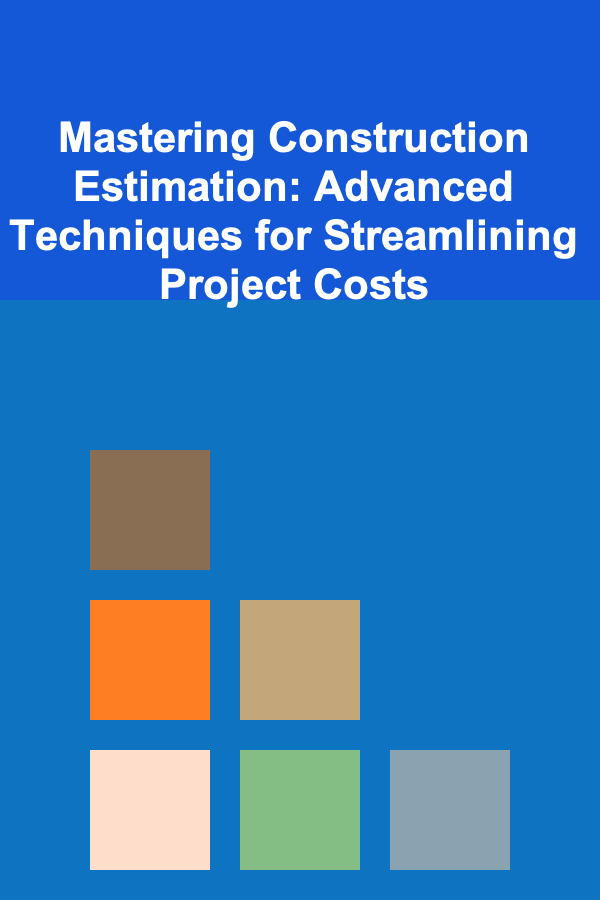
Mastering Construction Estimation: Advanced Techniques for Streamlining Project Costs
ebook include PDF & Audio bundle (Micro Guide)
$12.99$9.99
Limited Time Offer! Order within the next:

Construction estimation is both an art and a science, requiring precise calculations, a deep understanding of materials and labor costs, and the ability to predict potential risks and uncertainties. In an industry where financial miscalculations can lead to costly overruns, mastering advanced construction estimation techniques is essential for anyone seeking to improve project profitability, accuracy, and efficiency.
In this actionable guide, we'll delve deep into the most advanced techniques for streamlining construction project costs. By utilizing these strategies, estimators can refine their bidding process, enhance project performance, and contribute to the overall success of their projects.
Advanced Estimation Techniques
1. Embracing Building Information Modeling (BIM)
Building Information Modeling (BIM) is revolutionizing the construction industry, offering a digital representation of the physical and functional aspects of a construction project. By incorporating BIM into your estimation process, you can significantly improve the accuracy of your cost assessments, reduce rework, and streamline project workflows.
Why BIM Is Crucial for Estimators:
- Enhanced Visualization: BIM allows you to visualize the entire project in 3D before construction begins. This helps to identify potential design flaws, material requirements, and spatial limitations early on.
- Quantification and Automation: BIM software can automatically generate quantities for materials, reducing the chance of human error and speeding up the takeoff process. It can also update in real-time if any changes occur in the design.
- Collaboration: BIM enhances communication between all project stakeholders. When all team members (architects, engineers, contractors, etc.) have access to the same BIM model, any changes made are instantly reflected, minimizing the risk of discrepancies and misunderstandings.
Actionable Tip:
Start by incorporating BIM tools into your estimation process. Familiarize yourself with platforms like Revit, Navisworks, or AutoCAD, and gradually transition your manual takeoff process into a digital one to enhance accuracy and reduce time spent on manual calculations.
2. Unit Cost Estimating Method
The unit cost estimating method involves calculating the cost per unit of materials, labor, or equipment required for a specific task in the project. This approach works especially well when dealing with repetitive tasks or well-defined construction processes, such as drywall installation or concrete pouring.
Why Unit Cost Estimating Is Effective:
- Consistency: By using unit costs based on historical data, estimators can standardize the pricing for similar tasks across projects, ensuring that your estimates are both accurate and consistent.
- Easier Comparison: This method allows you to break down complex projects into smaller, more manageable tasks, making it easier to compare costs across different stages of construction.
- Faster Calculations: Unit cost estimating enables you to quickly calculate the total cost for each work item, which can streamline your estimation process, especially when dealing with large-scale projects.
Actionable Tip:
Compile a comprehensive database of unit costs from previous projects, including labor rates, material costs, and overheads. Update these costs regularly to ensure your estimates are aligned with current market conditions.
3. Resource Loading and Cost Allocation
Resource loading involves allocating the appropriate amount of labor, materials, and equipment to each specific task based on the project timeline. This technique allows you to match resources to the project schedule, which in turn helps you generate more accurate cost projections.
Why Resource Loading Matters:
- Improved Scheduling: When you allocate resources to specific tasks on a schedule, you can better predict when costs will be incurred, making it easier to plan cash flow and identify potential delays.
- Realistic Budgets: By integrating resources into your cost estimation process, you gain a more realistic view of the project's expenses. This is particularly beneficial when dealing with large or complex projects where multiple trades and subcontractors are involved.
- Optimized Resource Management: Accurate resource loading helps prevent over-allocation or under-allocation of resources, ensuring that you are neither overstaffing nor running short of critical materials or labor.
Actionable Tip:
Work closely with project managers and subcontractors to ensure that resource allocation is accurately reflected in the project schedule. Regularly update your resource loading as the project progresses and adjust for any unforeseen changes in scope or schedule.
4. Risk Management and Contingency Planning
Effective risk management is a critical aspect of advanced construction estimation. Unforeseen circumstances, such as inclement weather, design changes, or material shortages, can lead to cost overruns and delays. Contingency planning involves including a buffer in your estimates to account for these potential risks.
Why Risk Management Is Vital:
- Predicting Unknowns: Construction projects are inherently unpredictable. Proper risk management allows you to predict and plan for various challenges that could arise during the project.
- Protection Against Overruns: Including a contingency buffer in your bid can protect the project's financial viability, ensuring that you have room to cover unforeseen costs without impacting the project's success.
- Improved Decision Making: Risk management strategies, such as Monte Carlo simulations or sensitivity analysis, allow you to model potential outcomes and assess the financial impact of various scenarios.
Actionable Tip:
Use historical data from past projects to assess common risks and the typical impact they have on project costs. Implement risk analysis techniques like Monte Carlo simulations or decision tree analysis to forecast and plan for potential challenges more effectively.
5. Value Engineering (VE) for Cost Optimization
Value Engineering (VE) is a systematic method to improve the value of a project by assessing its functions and identifying cost-effective alternatives that maintain or enhance quality. VE focuses on reducing unnecessary costs without compromising the project's quality or performance.
Why Value Engineering Is Beneficial:
- Cost Reduction: VE allows you to identify areas where costs can be reduced without affecting the functionality or safety of the project.
- Innovative Solutions: This technique encourages creative problem-solving, which can result in new ideas and innovative methods that can optimize project costs.
- Stakeholder Collaboration: Value engineering fosters collaboration between designers, engineers, and contractors, ensuring that cost-cutting measures are viable and practical.
Actionable Tip:
Implement VE workshops early in the project's design phase. Invite key stakeholders to discuss potential design improvements, alternative materials, or more efficient construction methods that could lower overall costs while maintaining project quality.
6. Applying Historical Data and Benchmarking
Historical data from previous projects is one of the most powerful tools an estimator has. By reviewing past estimates, actual costs, and project performance, you can better predict future project costs and improve the accuracy of your bids. Benchmarking involves comparing your estimates to industry standards or similar projects to ensure competitiveness.
Why Historical Data and Benchmarking Are Important:
- Data-Driven Estimates: Historical data allows you to draw on past experiences to inform future projects, ensuring that your estimates are based on real-world data rather than assumptions.
- Accuracy in Pricing: By comparing your estimates to industry benchmarks or similar projects, you can adjust for any discrepancies and ensure that your bids are competitive.
- Continuous Improvement: Benchmarking and reviewing past performance help identify areas for improvement in your estimating process, allowing you to refine your techniques and reduce discrepancies between estimated and actual costs.
Actionable Tip:
Create a database of historical cost data from previous projects, including labor rates, material costs, and any unforeseen issues. Use this information to create a more robust cost database and compare estimates with industry averages or similar projects in your portfolio.
7. Leveraging Artificial Intelligence and Machine Learning
Artificial Intelligence (AI) and machine learning (ML) are increasingly being used in construction estimation to improve accuracy, predict future costs, and optimize resource allocation. These technologies analyze vast amounts of data from past projects to identify patterns and make predictions about future cost trends.
Why AI and ML Are Game-Changers:
- Predictive Analytics: AI-powered tools can predict potential cost overruns based on historical data, enabling proactive cost management.
- Automation: Machine learning algorithms can automate routine estimating tasks, such as material quantity takeoffs, saving valuable time for estimators.
- Cost Forecasting: AI can also forecast material price trends, labor availability, and other external factors that could impact project costs, helping you make more informed decisions.
Actionable Tip:
Explore AI-powered estimation tools like ProEst or Construction Cost Estimating Software, which integrate machine learning to provide more accurate cost predictions and automate certain tasks. Stay informed about AI trends in construction to implement cutting-edge technologies into your estimation practices.
Conclusion
Mastering advanced construction estimation techniques is essential for staying competitive and delivering profitable projects in an increasingly complex and data-driven industry. By leveraging technologies like BIM, unit cost estimating, resource loading, risk management, value engineering, historical data, and AI, estimators can streamline their workflows, reduce errors, and improve cost predictions.
Adopting these strategies will not only enhance your estimating accuracy but also help you contribute to the overall success of your projects. As construction projects grow in scale and complexity, the role of an estimator becomes more critical---those who continuously refine their skills and embrace innovation will be best positioned to lead the industry in the coming years.
Reading More From Our Other Websites
- [Soap Making Tip 101] The Ultimate Guide to Solving Soap-Making Fragrance Fade
- [Organization Tip 101] How to Choose the Right Emergency Power Generator for Your Home
- [Organization Tip 101] How to Choose Decor That Helps Maintain an Organized Look
- [Home Space Saving 101] How to Use Multi-Functional Furniture to Save Space
- [Home Maintenance 101] How to Maintain Your Home's Insulation for Maximum Efficiency
- [Home Rental Property 101] How to Use Social Media to Market Your Rental Property
- [Home Cleaning 101] How to Choose the Best Microfiber Cloths for Cleaning: Your Go-To Guide for Streak-Free Shine
- [Organization Tip 101] How to Create an Essential Oil Gift Basket for Loved Ones
- [Personal Care Tips 101] How to Do an At-Home Pilates Routine for Back Pain Relief
- [Personal Investment 101] How to Invest in a Bear Market (and Profit)

How to Build a Checklist for Book Club Member Feedback
Read More
How to Create a Clutter-Free Outdoor Space
Read More
How to Make Money Online as a Social Worker: 10 Actionable Ideas
Read More
How to Use Budgeting Tools to Simplify Your Finances
Read More
How to Manage Employee Mental Health and Wellbeing
Read More
10 Tips for Batching Tasks to Save Time and Money
Read MoreOther Products

How to Build a Checklist for Book Club Member Feedback
Read More
How to Create a Clutter-Free Outdoor Space
Read More
How to Make Money Online as a Social Worker: 10 Actionable Ideas
Read More
How to Use Budgeting Tools to Simplify Your Finances
Read More
How to Manage Employee Mental Health and Wellbeing
Read More